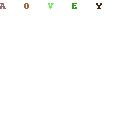Tomorrow night, be on the lookout for the waning moon (after all, yesterday was the worm moon — the first full moon in March) sandwiched between Spica and Saturn. You will be able to find the moon midway between the star and the planet, which are currently 17° apart.
Spica will be the white star to the moon’s upper right and Saturn will be more creamy-colored down to the moon’s lower left. Because such a full moon would usually wash out anything in its near vicinity, this degree of separation will actually help the casual observer spot the trio. It will be easiest to spot this celestial arrangement in the southeast after 11 p.m.
 |
Spica is the brightest star in the
constellation Virgo
Light from the moon, reflected from the sun, takes only 1.25 seconds to
reach the earth. The light from Saturn, 830 million miles away, takes about 74
minutes. However, the light from Spica, a 1st magnitude blue giant,
takes about 260 years to finally reach our eyes. So be aware that the light
you'll see left the brilliant star well before the American Revolution.
For more on lunar occulations — and the best time to see this trio in
your area — check out details here.
No comments:
Post a Comment